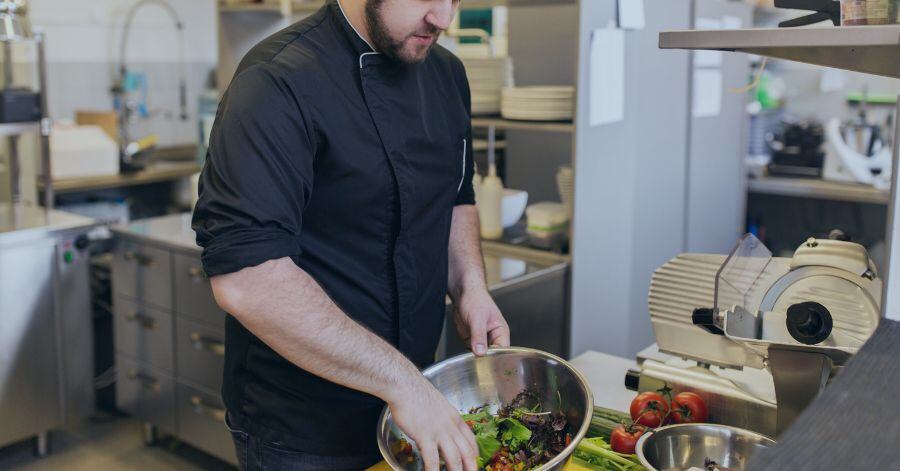When it comes to running your restaurant, there aren’t many more important things than keeping your kitchen stocked with the right ingredients. Having enough stock ensures smooth operations and happy customers.
But what happens when your suppliers are delayed, or demand suddenly spikes? That’s where safety stock comes in.
Understanding and calculating your safety stock can prevent those dreaded "out of stock" moments that can have a significant impact on your restaurant’s operations, customer satisfaction, and your profit margins.
In this blog, we’re going to take a closer look at what safety stock is and how you can calculate it.
What is Safety Stock?
Safety stock is like a buffer or cushion of extra inventory that helps you deal with unexpected situations.
In a restaurant, safety stock is the extra ingredients or supplies you keep on hand to cover you in case of delays in deliveries, sudden changes in customer demand, or mistakes in forecasting. The goal is to avoid running out of key items, which could disrupt service, reduce sales, and frustrate customers.
Having the right amount of safety stock ensures that your restaurant can continue operating smoothly, even when things don’t go exactly as planned. It’s all about being prepared for the unexpected and preventing those last-minute scrambles for ingredients when you’re busy.
How to Calculate Safety Stock
Calculating safety stock involves understanding a few key factors, including the variability in demand for certain items and the lead time it takes for suppliers to deliver. To calculate your safety stock for each inventory item, you’ll need four things:
- Maximum Daily Usage: The highest amount of an ingredient you expect to use in a single day.
- Maximum Lead Time: The longest time it might take for your supplier to deliver an order.
- Average Daily Usage: The average amount of the ingredients you use per day.
- Average Lead Time: The usual time it takes for a delivery to arrive.
Once you have the above four pieces of information for each piece of inventory, you can then use this simple formula to calculate safety stock:
Safety Stock = (Maximum Daily Usage × Maximum Lead Time) − (Average Daily Usage × Average Lead Time)
While it’s possible to calculate safety stock manually, inventory management software can make the process much easier. Inventory management software integrated with your point of sale (POS) system and automatically tracks your usage patterns, supplier lead times, and even seasonal trends, using this data to recommend ideal safety stock levels.
By automating these calculations, you can save time to either focus on running more critical areas of your restaurant or even taking that vacation you’ve always wanted to.
10 Reasons Why the Safety Stock Calculation is Important for Your Restaurant
Now that you know what safety stock is and how to calculate it, let’s explore why it’s such a critical metric for your restaurant.
- Prevent Stockouts
Few things are more frustrating for both your staff and customers than running out of a key ingredient in the middle of service. Stockouts can lead to menu items being unavailable, disappointing customers and potentially losing business. With a proper safety stock calculation, you can avoid these stockouts and ensure you have the necessary supplies to keep serving even during busy times or periods where you are experiencing supplier delays.
- Handle Supplier Delays
Suppliers aren’t always predictable. Whether it's due to transportation issues, weather conditions, or stock shortages on their end, delays happen. A well-calculated safety stock acts as a buffer, giving you enough time to continue operations without having to panic about missing deliveries.
- Adapt to Sudden Spikes in Demand
It’s common for restaurants to experience unexpected surges in customer traffic - whether from a sudden local event, a great review, or even seasonal changes. Without safety stock, these spikes can quickly deplete your inventory, leaving you scrambling to meet demand. By calculating safety stock based on potential demand variability, you’ll be able to absorb these fluctuations smoothly.
- Reduce Stress for Your Staff
Your staff already have enough on their plate without having to worry about running out of critical ingredients mid-service. When stockouts occur, it creates chaos in the kitchen, forcing cooks and servers to scramble for substitutes or inform customers that their desired dish is unavailable. This adds unnecessary stress, disrupts your team’s workflow, and can lower morale. Safety stock significantly reduces your risk in all of those areas.
- Avoid Last-Minute Orders
When inventory unexpectedly runs low, you may have to place emergency orders from your suppliers, often paying a premium for expedited delivery. Not only is this inefficient, but it also eats into your profit margins. By having a buffer of safety stock, you reduce the need for these costly, last-minute orders.
- Minimize Your Restaurant’s Waste
Overstocking can lead to spoilage and waste, which is just as bad for your bottom line as understocking. Calculating safety stock properly allows you to strike the right balance between having enough inventory to avoid stockouts and not overordering perishable items that may go bad.
When you fine-tune your safety stock levels, you ensure you’re only holding the necessary amount of ingredients, reducing the risk of throwing away spoiled products and improving your food cost control. This also helps you understand your PAR level for each inventory item, so you know exactly when, and how much, to order from your suppliers.
For more tips on reducing waste, read our blog: Smart Steps to Cut Down on Restaurant Food Waste.
- Improve Customer Satisfaction
Customer satisfaction is the lifeblood of any restaurant, and nothing disappoints a customer more than hearing their favourite dish is unavailable because you’ve run out of ingredients. Safety stock helps prevent this scenario, allowing you to consistently offer your full menu and keep your customers happy. Happy customers are more likely to return, leave positive reviews, and recommend your restaurant to others, which is crucial for building long-term success.
- Implement Improved Inventory Control
Safety stock forces you to take a more disciplined approach to inventory management. By regularly monitoring usage patterns, supplier lead times, and fluctuations in demand, you gain a deeper understanding of your inventory needs. This improves your overall inventory control, making it easier to forecast accurately and reduce unnecessary stockpiling.
- Boost Your Profit Margins
When your safety stock is well-managed, you’re less likely to run into emergencies that force you to make quick, often expensive, decisions. Avoiding stockouts, last-minute orders, and wasted ingredients helps control food costs, allowing you to maintain healthy profit margins.
- Ensure Consistent Service
Last but not least, we have consistency - a key component of keeping customers happy and coming back to your restaurant. No one likes visiting a restaurant and finding their favourite dish unavailable or the service slower than usual because of missing ingredients. With properly calculated safety stock, you can offer a consistent dining experience, no matter the external circumstances.
Are you looking to improve your inventory management processes through technology and expert support? The Sculpture Hospitality team would love to help save you time and increase your profits. Contact us today.











